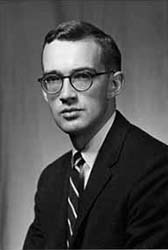Hartley Rogers, Jr.
Professor Emeritus of Mathematics
Published: July 22, 2015

Photo courtesy of the MIT Museum.
Hartley Rogers, Jr., professor emeritus of mathematics at MIT, died at the Meadow Green Rehabilitation and Nursing Center in Waltham, Massachusetts, on Friday, July 17. He was 89.
Rogers joined the MIT mathematics faculty in 1956 as an assistant professor, following a year’s visit at MIT. He was promoted to full professor in 1964, and retired from MIT in 2009.
Rogers’ research interests were in mathematical logic, and he is credited as one of the main developers of recursion theory, and of the usefulness and validity of informal methods in this area. His 1959 paper “Computing Degrees of Unsolvability” obtained semantical completeness results for higher levels of arithmetical complexity, and underlies current methodology in studies of computable structures. Rogers authored the 1967 book “Theory of Recursive Functions and Effective Computability,” which has become a central and standard reference in the field, and remains in print.
Rogers served as vice president of the Association for Symbolic Logic, senior editor of the Journal of Symbolic Logic, senior editor of Annals of Mathematical Logic, and associate editor of the Journal of Computer and Systems Sciences. Among his distinctions, Rogers received the Lewis R. Ford Award of the Mathematical Association of America for his expository papers in 1965.
Rogers’ career at MIT included significant administrative service during the 1960s and 1970s. From 1962 to 1964, he was a member of the Committee on Curriculum Content Planning, whose report radically modified the General Institute requirements for undergraduate education. In 1968, he chaired the Panel on November Events and the MIT Community, whose findings further developed the judicial processes of the Institute. Rogers served as chair of the MIT faculty from 1971 to 1973, and as associate provost from 1974 to 1980. He chaired the editorial board of the MIT Press from 1974 to 1981, as the press became an arm of the Institute’s educational mission.
At Rogers’ suggestion in 1996, the Department of Mathematics initiated its Summer Program in Undergraduate Research (SPUR). Teams pair a graduate student mentor with an MIT undergraduate; each team then works intensively on a research problem over a six-week summer period, culminating with the undergraduate giving a presentation and submitting written materials to a group of math faculty. Under Rogers’ direction through 2006, SPUR became popular with students who saw its educational benefits.
In 2001, the Rogers family established the Hartley Rogers, Jr. Prize for the top SPUR teams selected by the faculty. The prize has not only boosted the competitive spirit of its participants, but has attracted participation by graduate students from Harvard University and exchange students from Cambridge University.
From 1993 to 2006, Rogers supervised the MIT mathematics section of the Research Summer Institute program for advanced high school students. From 1995 to 2008, he also helped develop the MIT problem-solving seminar into an important resource for students, especially freshmen, interested in participating in the William Lowell Putnam Mathematics Competition. (Each year, he invited all attendees to his home in Winchester, Massachusetts, for dinner prior to the competition.) During this period, MIT’s Putnam team placed among the top three teams 10 times, twice in first place.
Rogers was a popular and respected teacher, particularly with his development of course 18.022 (Multivariable Calculus with Theory). In 1993, he received the Teaching Prize for Undergraduate Education from the School of Science. Rogers’ graduate lectures in mathematical logic were known for their beauty and clarity, and he was known for assigning challenging problem sets. He produced 19 doctoral students at MIT, with 557 mathematical “descendants” in total.
“[Rogers] presented an innovative, intuitive approach to recursion theory (computability) in his lectures and classic text,” says Richard Shore, a professor of mathematics at Cornell University and former president of the Association for Symbolic Logic, who studied with Rogers as a PhD student under Gerald Sacks from 1968 to 1972. “His approach was a major influence on my development and on all other students of the subject for the past 50 years. He was both a gentleman and a scholar who was devoted to his students, university, and academic community. For me, personally, he was a model and mentor for professional conduct and service to the community for many years.”
Along with mathematics, Rogers maintained a love for English literature, the field of his undergraduate degree. In the 1960s, he took up rowing with a passion. He was a founding member of the Charles River All Star Has-Beens (CRASH-B) sprints, and served as its unofficial guru for three decades. He won numerous medals at the CRASH-B sprints as well as at World Rowing Masters competitions, and in the Head of the Charles Regatta. He was the president of Boston Rowing Center, which prepared many top athletes for the U.S. national team, in the 1980s and early 1990s.
Hartley Rogers, Jr., was born in Buffalo, New York, on July 6, 1926. He received his BA in English from Yale University in 1946. Following a year at Cambridge University as a Henry Fellow, he returned to Yale to complete his MS in physics in 1950. He continued his studies at Princeton University in mathematics, receiving his MA in 1951 and his PhD in 1952, with Alonzo Church was his thesis advisor. Rogers’ first academic appointment was as Benjamin Peirce Lecturer at Harvard from 1952 to 1955.
Rogers was a devoted father, fiercely proud of his children and their accomplishments. He is survived by his wife, Dr. Adrianne E. Rogers; by his three children, Hartley R. Rogers, Campbell D.K. Rogers, and Caroline R. Broderick; and by 10 grandchildren.
Gifts in Rogers’ memory may be made to the Hartley Rogers Jr. Fund in the Department of Mathematics.
